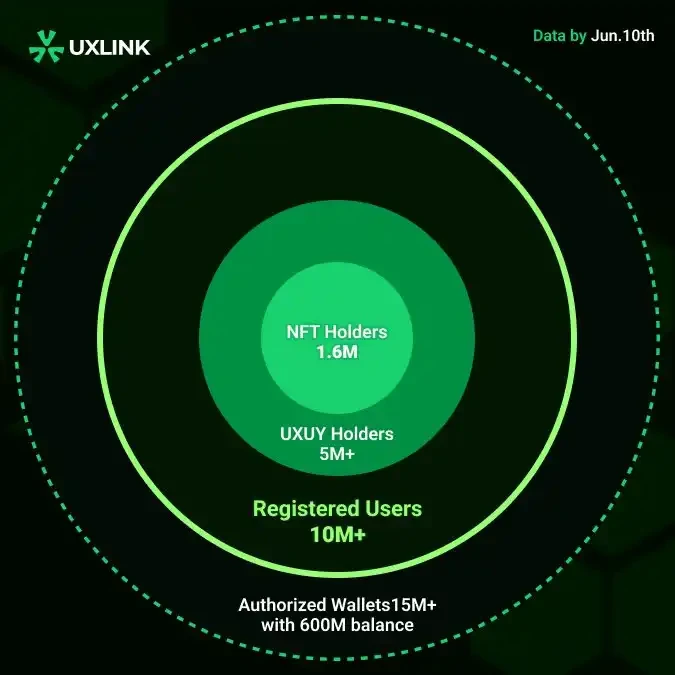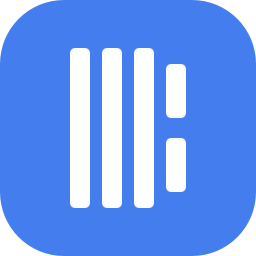Today, UXLINK announced that it has more than 10 million registered users, becoming the first product in the Web3 SocialFi category to reach tens of millions of users. Regarding the data, we immediately interviewed the technical director of the UXLINK community:

Image source: UXLINK
1. Most blockchain projects are measured by the number of independent wallet addresses. Why does UXLINK propose the registered users metric? What is the difference between it and the number of independent wallet addresses?
It is mainly used to solve two problems:
(1) There are too many invalid and fake Sybil wallet addresses in Crypto, which are meaningless and will pollute the data.
(2) We are social, and we advocate the concept of people/Account, because only when people connect with each other can it be considered social, and a person can have multiple wallets for different purposes.
So we use the concept of registered users to measure, and registered users need to pass three levels:
(1) 100% invitation relationship, entry through Link-to-Earn, new users must be invited by acquaintances or partners from the UXLINK network and register with an invitation code
(2) Human-computer interaction is required to prove that it is not a BOT
(3) Using UXLINK products
If you meet the above criteria, you will be counted as a registered user of UXLINK, so the number of registered users is less than the number of independent wallet addresses. Currently, the number of registered users of UXLINK has exceeded 10 million, and the number of connected authorized wallet addresses is 15 million. Each user can have multiple wallets.
Does every user have a wallet? Yes, if the user comes from Web2 and does not have a wallet, we will give him an MPC wallet. Even if this wallet does not have assets for the time being, if this user contributes to the community, he is also a good user. Social Mass Adoption is our mission and work. It can also be said that 100% of the users in the UXLINK network are WEB3 users.
Is every wallet a user? Not necessarily. We use social verification, diversified tasks, access verification, third-party reputation systems and other methods to prevent witches, and block tens of millions of invalid and fake witch wallet addresses. Of course, we cant block them all to avoid hurting real users.
Does every user have a social media account? Not necessarily. We still fully respect user privacy. Some users only have a wallet, or come in through a social media account, and then cancel the social media account. We will also provide good service.
2. What is the concept of UXUY Holders? Is it the number of holders of our token?
First of all, UXUY is a kind of on-chain POW points of UXLINK, which is used to record and motivate the growth and interaction of community users and cannot be transferred. UXUY is all produced through the formula of LINK 2 EARN, without reservation and pre-mint, and all comes from the POW mining output of community users. The key words are POW, on-chain, and non-transferable.
UXUY Holders need to meet 3 criteria:
1. Registered users wallet
2. Contribute to the POW behavior set by the community and obtain UXUY
3. ClaimUXUY on the chain. That is, if there is no claim, it does not count as a UXUY holder.
Therefore, UXUY Holders are community contributors, WEB3 users, and potential governance token holders. Currently, there are 5 million UXUY Holders.
Will the number of UXUY Holders increase? Yes, with continuous community contributions, it will increase until there are more than 30 million registered users and UXUY is mined out. By then, we believe that a very positive network effect has been formed.
Will the number of UXUY Holders decrease? Yes, if some Holders exchange UXUY for other assets, it will decrease, such as NFT or governance tokens.
3. How many holders does UXLINK have? What is the standard?
There are three dimensions for measuring NFT Holders: community contribution, on-chain interaction, and the number of assets in the wallet address.
Before TGE, our approach is: UXUY holders, after UXUY reaches a certain level, use UXUY to exchange NFTs of different levels. NFT is the certificate of airdrop, and $UXLINK will be obtained before TGE according to the level and quantity of NFT. At that time, there will be another de-Wyrk process.
So, to put it simply, before TGE: NFT holders = TOKEN holders
After TGE, the number of holders will include all legal and legitimate uxlink holders, including those who purchase and continue to contribute to the community.
We currently have 1.6 million Holders, and this number will increase or decrease as liquidity is released.
4. Faced with such a large number of registered users and holders, will we perform witch removal?
Of course, witch accounts are very common in WEB3. The biggest purpose of removing witches is to ensure the interests of real and high-quality users in the community. We do this in three steps:
Step 1: Determine whether it is a fake request based on human-machine or access compliance verification. We directly block it from the system, so it is neither considered a registered user nor generates UXUY from LINK-TO-EARN. This step can block most of them, but it should not be too strict, otherwise it will hurt real users.
Step 2: After entering the UXLINK network, UXUY is generated; we will remove it again based on community contribution and activity. For example, if there is no activity for 6 months or no successful claim of UXUY, the unchained UXUY will be recycled and circulated into the community to incentivize high-quality users. This is a redistribution process to ensure that only users who truly bring value to the community will be incentivized.
Step 3: Before TGE, the community will conduct another round of de-Wizarding. The method will be announced by the community, and the recycled UXUY will re-enter the community to incentivize high-quality users.
Through the above three steps, the quality, fairness and efficiency of the community can be ensured.
5. We see many media comparing UXLINK with NOTCOIN, saying that UXLINK’s on-chain data is better than NOTCOIN. What do you think?
UXLINK and NOTCOIN belong to different fields, one is a social platform and infrastructure, and the other is a game. The two do have some similarities. Both have Mass Adoption as one of their missions and have a large number of users. From my perspective, NOTCOIN has a larger overall user base, while UXLINK has higher on-chain data and user stickiness. For example, the daily and monthly active users on the chain, the ratio of daily active users to weekly active users, and weekly active users to monthly active users are all higher than NOT, and the proportion of monthly active users on the chain accounts for more than 50% of the total registered users; the number of UXLINK holders is also much higher than before NOT TGE.
I think there are three main reasons:
(1) User interaction in social products is much deeper than that in games. Users participate in social interactions such as SBT/SocialGraph, groups, invitations, learning check-ins, etc., as well as asset-related interactions such as SWAP, Airdrop, and Pre-Market. However, the interaction of NOTCOIN is relatively pure, Tap-to-Earn, and relatively shallow. The depth is determined by the track, regardless of good or bad.
(2) User stickiness is related to social relationships and groups. Real-world social relationships and our more than 100,000 groups bring trust and higher user retention.
(3) Overall, this is also related to the UXLINK registered user screening mentioned above. After three rounds of anti-witch and de-witch, although the total number of registered users seems to be smaller, the quality has improved.
UXLINK and NOTCOIN are both very good products, and they do provide effective paradigms from web2 to web3; from offchain to onchain. We need to learn from NOTCOIN in many aspects, and we are very much looking forward to working with NOTCOIN.
Finally, as the technical director, how do you view the future product development and direction of UXLINK?
Back to our essence, we build trust through social relationships among acquaintances, while serving users social platforms and developers infrastructure. In the future, we will work with ecological partners to build a socialized asset generation, flow and distribution layer, allowing users to use various applications in a trusted, safe and simple manner without complex interactions such as cross-chain, and to gain benefits through their own social assets; allowing developers to make full use of our protocols, social relationships and data, and greatly improve development efficiency and growth quality through modular products and APIs.










